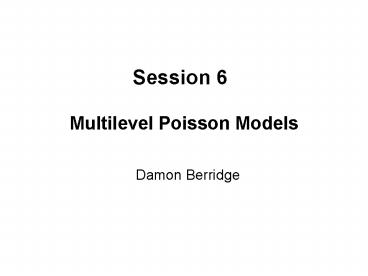Multilevel Poisson Models - PowerPoint PPT Presentation
1 / 11
Title:
Multilevel Poisson Models
Description:
Another important type of discrete data is count data. For example, for a population of ... of , so long as the mean is positive, as discussed in Dobson (1991) ... – PowerPoint PPT presentation
Number of Views:25
Avg rating:3.0/5.0
Title: Multilevel Poisson Models
1
Multilevel Poisson Models
Session 6
Damon Berridge
2
Multilevel Poisson Models
- Another important type of discrete data is count
data. - For example, for a population of road crossings
one might count the number of accidents in one
year or for a population of doctors, one could
count how often in one year they are confronted
with a certain medical problem. - The set of possible outcomes of count data is the
set of natural numbers - The standard distribution for counts is the
Poisson distribution.
3
Multilevel Poisson Models
- The Poisson distribution has some properties that
we can make use of when modelling our data. For
example, the mean is equal to the variance - When we have Poisson distributed data, it is
usual to use a logarithmic transformation to
model the mean - There is no theoretical restriction, however, on
using other transformations of , so long as
the mean is positive, as discussed in Dobson
(1991).
4
Poisson Regression Models
- In Poisson regression it is assumed that the
response variable has a Poisson distribution
given the explanatory variables - where the log of the mean is assumed to be a
linear function of the explanatory variables - which implies that the mean is the exponential
function of independent variables
5
Poisson Regression Models
- In models for counts it is quite usual that there
is a variable mij - that is known to be proportional to the expected
counts. - For example, if the count is the number of events
in some time interval of non-constant length, it
is often natural to assume that the expected
count is proportional to this length of the time
period. - In order to let the expected count be
proportional to mij there should be a term
log(mij ) in the linear model with a regression
coefficient fixed to 1. - Such a term is called an offset in the linear
model (see e.g., McCullagh and Nelder, 1989
Goldstein, 2003). Therefore, the Poisson
regression model can be written in the following
form
6
The Two-Level Poisson Model
- is the count for level-1 unit i in level 2 unit
j, - Level-1 Model
- Level-2 Model The Random Intercept Model
- Regression model plus a random intercept for the
logarithm of the expected count, - So that
7
The Two Level Poisson Model Likelihood
- where
- and
8
Poisson Model Example C5
- Cameron and Trivedi (1988) use various forms of
overdispersed Poisson model to study the
relationship between type of health insurance and
various responses which measure the demand for
health care, such as the total number of
prescribed medications used in past 2 days. - The data set they use in this analysis is from
the Australian Health survey for 1977-1978. - Data description
- Number of observations (rows) 5190
- Number of variables (columns) 21
9
Poisson Model Example C5
- Variables
- sex 1 if respondent is female, 0 if male
- age respondent's age in years divided by 100,
- agesq age squared
- income respondent's annual income in Australian
dollars divided by 1000 - levyplus 1 if respondent is covered by private
health insurance fund for private patient in
public hospital (with doctor of choice), 0
otherwise - freepoor 1 if respondent is covered by
government because low income, recent immigrant,
unemployed, 0 otherwise - freerepa1 if respondent is covered free by
government because of old-age or disability
pension, or because invalid veteran or family of
deceased veteran, 0 otherwise - illness number of illnesses in past 2 weeks
with 5 or more coded as 5 - actdays number of days of reduced activity in
past two weeks due to illness or injury - hscore respondent's general health
questionnaire score using Goldberg's method, high
score indicates bad health. - chcond1 1 if respondent has chronic
condition(s) but not limited in activity, 0
otherwise - chcond2 1 if respondent has chronic
condition(s) and limited in activity, 0 otherwise - dvisits number of consultations with a doctor
or specialist in the past 2 weeks - nondocco number of consultations with
non-doctor health professionals, (chemist,
optician, physiotherapist, social worker,
district community nurse, chiropodist or
chiropractor in the past 2 weeks - hospadmi number of admissions to a hospital,
psychiatric hospital, nursing or convalescent
home in the past 12 months (up to 5 or more
admissions which is coded as 5) - hospdays number of nights in a hospital, etc.
during most recent admission, in past 12 months - medicine total number of prescribed and
nonprescribed medications used in past 2 days - prescribe total number of prescribed
medications used in past 2 days
10
Poisson Model Example C5
11
Poisson Model Example C5
Even with a range of explanatory variables, there
is still a highly significant amount of between
respondent variation in, total number of
prescribed medications.

